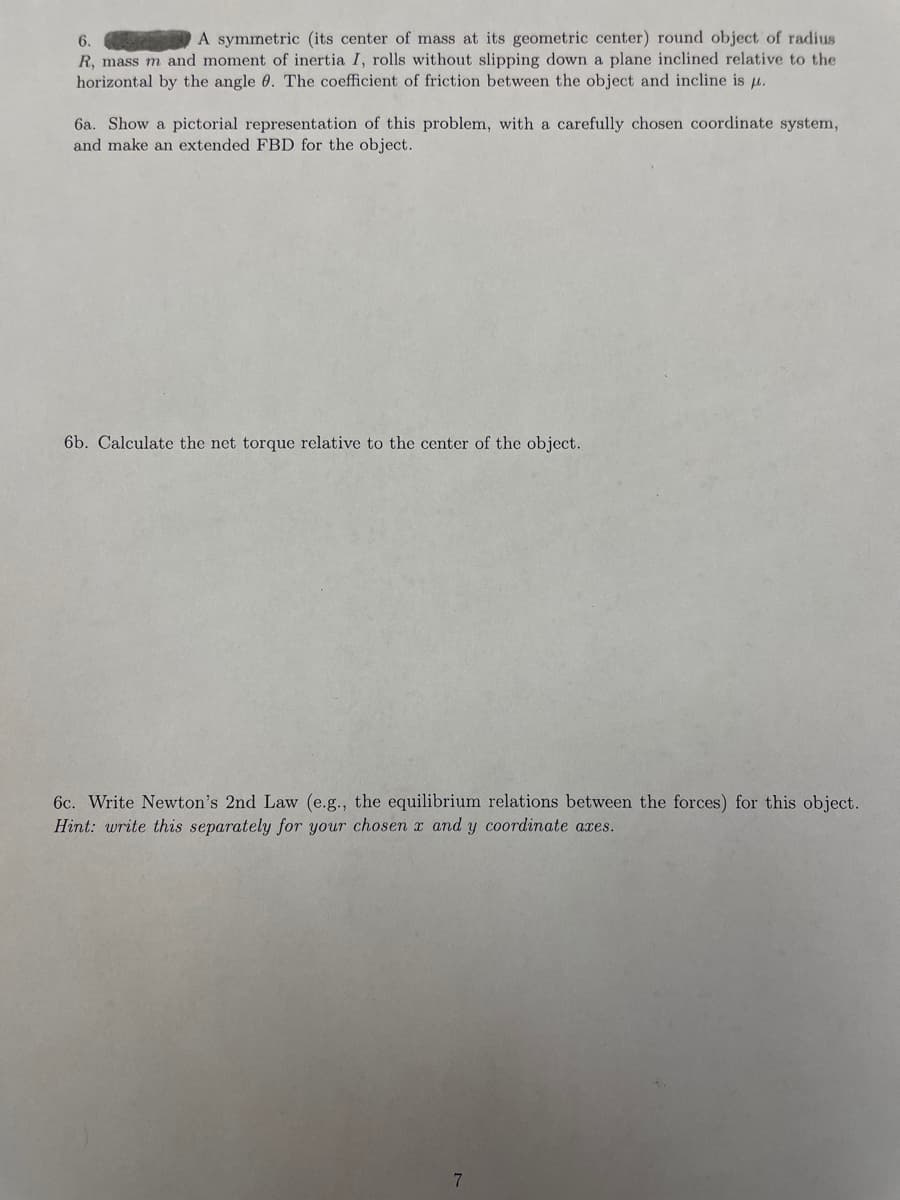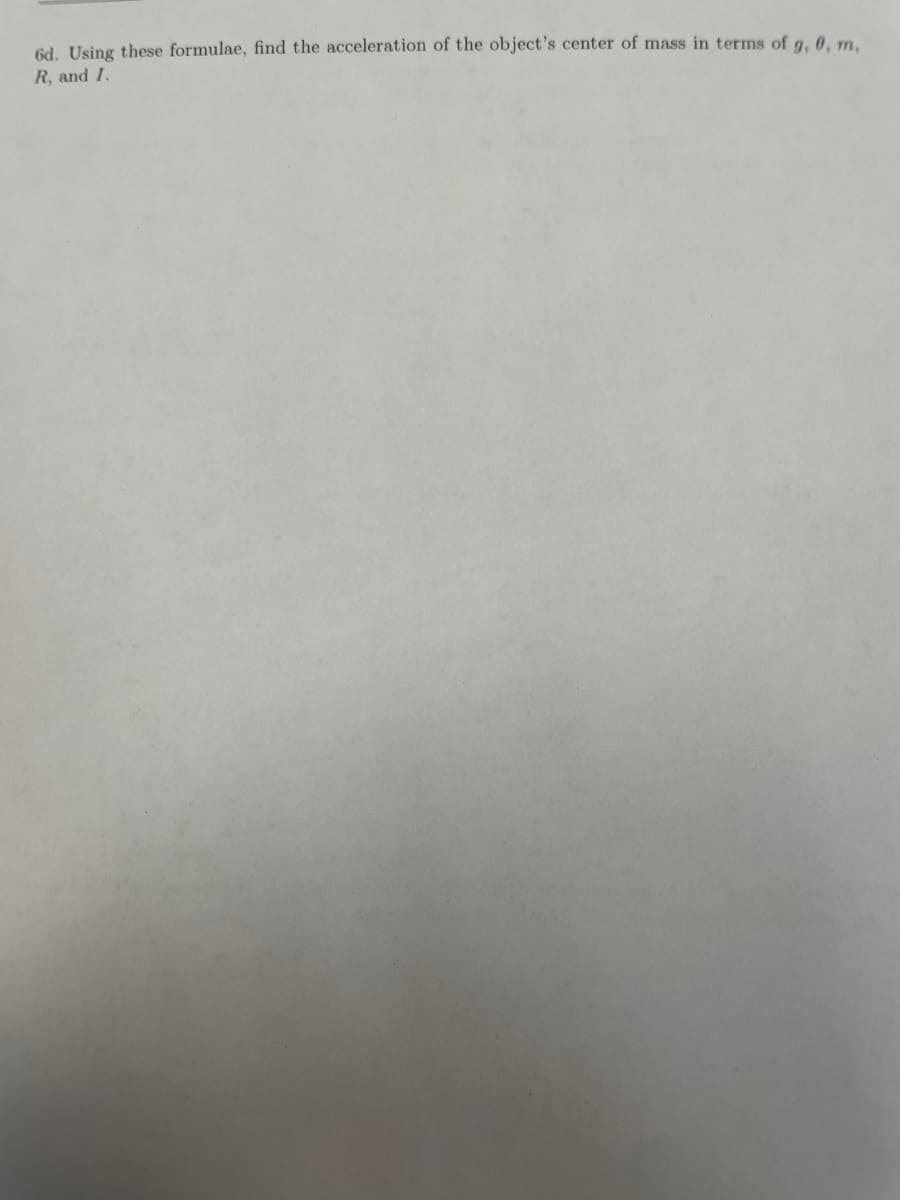6. A symmetric (its center of mass at its geometric center) round object of radius R, mass m and moment of inertia I, rolls without slipping down a plane inclined relative to the horizontal by the angle 0. The coefficient of friction between the object and incline is μ. 6a. Show a pictorial representation of this problem, with a carefully chosen coordinate system, and make an extended FBD for the object. 6b. Calculate the net torque relative to the center of the object. 6c. Write Newton's 2nd Law (e.g., the equilibrium relations between the forces) for this object. Hint: write this separately for your chosen x and y coordinate axes.
6. A symmetric (its center of mass at its geometric center) round object of radius R, mass m and moment of inertia I, rolls without slipping down a plane inclined relative to the horizontal by the angle 0. The coefficient of friction between the object and incline is μ. 6a. Show a pictorial representation of this problem, with a carefully chosen coordinate system, and make an extended FBD for the object. 6b. Calculate the net torque relative to the center of the object. 6c. Write Newton's 2nd Law (e.g., the equilibrium relations between the forces) for this object. Hint: write this separately for your chosen x and y coordinate axes.
Physics for Scientists and Engineers: Foundations and Connections
1st Edition
ISBN:9781133939146
Author:Katz, Debora M.
Publisher:Katz, Debora M.
Chapter12: Rotation I: Kinematics And Dynamics
Section: Chapter Questions
Problem 35PQ: In testing an automobile tire for proper alignment, a technicianmarks a spot on the tire 0.200 m...
Related questions
Question

Transcribed Image Text:6.
A symmetric (its center of mass at its geometric center) round object of radius
R, mass m and moment of inertia I, rolls without slipping down a plane inclined relative to the
horizontal by the angle 0. The coefficient of friction between the object and incline is u.
6a. Show a pictorial representation of this problem, with a carefully chosen coordinate system,
and make an extended FBD for the object.
6b. Calculate the net torque relative to the center of the object.
6c. Write Newton's 2nd Law (e.g., the equilibrium relations between the forces) for this object.
Hint: write this separately for your chosen x and y coordinate axes.
7

Transcribed Image Text:6d. Using these formulae, find the acceleration of the object's center of mass in terms of g, 0, m,
R, and I.
Expert Solution
This question has been solved!
Explore an expertly crafted, step-by-step solution for a thorough understanding of key concepts.
This is a popular solution!
Trending now
This is a popular solution!
Step by step
Solved in 2 steps with 1 images

Knowledge Booster
Learn more about
Need a deep-dive on the concept behind this application? Look no further. Learn more about this topic, physics and related others by exploring similar questions and additional content below.Recommended textbooks for you

Physics for Scientists and Engineers: Foundations…
Physics
ISBN:
9781133939146
Author:
Katz, Debora M.
Publisher:
Cengage Learning

University Physics Volume 1
Physics
ISBN:
9781938168277
Author:
William Moebs, Samuel J. Ling, Jeff Sanny
Publisher:
OpenStax - Rice University

College Physics
Physics
ISBN:
9781305952300
Author:
Raymond A. Serway, Chris Vuille
Publisher:
Cengage Learning

Physics for Scientists and Engineers: Foundations…
Physics
ISBN:
9781133939146
Author:
Katz, Debora M.
Publisher:
Cengage Learning

University Physics Volume 1
Physics
ISBN:
9781938168277
Author:
William Moebs, Samuel J. Ling, Jeff Sanny
Publisher:
OpenStax - Rice University

College Physics
Physics
ISBN:
9781305952300
Author:
Raymond A. Serway, Chris Vuille
Publisher:
Cengage Learning

Principles of Physics: A Calculus-Based Text
Physics
ISBN:
9781133104261
Author:
Raymond A. Serway, John W. Jewett
Publisher:
Cengage Learning

College Physics
Physics
ISBN:
9781938168000
Author:
Paul Peter Urone, Roger Hinrichs
Publisher:
OpenStax College

Glencoe Physics: Principles and Problems, Student…
Physics
ISBN:
9780078807213
Author:
Paul W. Zitzewitz
Publisher:
Glencoe/McGraw-Hill